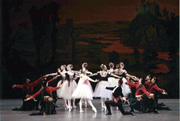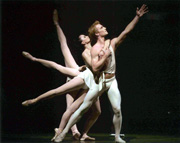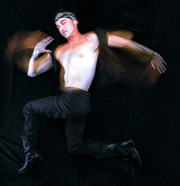Letter from New York
12
January 2004.
Copyright © 2004 by
Mindy Aloff

One of the
most illuminating passages of Girish Bhargava's bravura editing of Balanchine
is a series of clips that show a line of great Apollos, beginning
with a handsome 1969 performance by Peter Martins and working backward
through a joyous and musical excerpt from 1960 with Jacques d’Amboise
to the astonishingly physical and godlike Lew Christensen, shown on stage
in 1937. When one is able to compare performances this way, instantaneously,
one can recognize the qualities that make individual dancers great and
set them apart from anyone else. With the image in mind of Christensen’s
blazing approach to role of the young god, it is deeply saddening to contemplate
a story about the dancer that d’Amboise recounted this past Saturday,
in a “Times Talk” (Balanchine @ 100), moderated by Anna Kisselgoff,
chief Dance Critic of The New York Times, and featuring dancers
from several eras. D’Amboise’s anecdote concerned Christensen’s
breakdown on a battlefield, when he served as a soldier in World War II,
and the discovery of him in a field by Lincoln Kirstein, then serving
as a driver for an officer in Patton’s army.
read letter
Preview:
Must
See TV:
The Balanchine Biography
Balanchine,
Parts I and II
PBS
January 14, 2003
By
Dale Brauner
copyright © 2004 by Dale Brauner

Twenty years ago, PBS paid tribute to a true master of his field, choreographer George Balanchine, with a biography on its Great Performances series. With great research and thought, the makers of the program created a survey of interest and importance. It was called, Balanchine, Parts I & II, which was shown in two separate nights on May 28 and June 4, 1984. On January 14, to commemorate the centennial of Balanchine’s birth, PBS will for the first time rebroadcast the two-hour show on the American Masters series (fitting since Balanchine was proud of his adopted nationality and preferred being called ballet master). A DVD will be released in February.
The program—produced
by Judy Kinberg, written by Holly Brubach, directed by Merrill Brockway,
edited by Girish Bhargava, with Nancy Reynolds as research director—was
conceived to follow the example set by Balanchine’s Midsummer
Night’s Dream or Harlequinade—the first part
would follow the story line, the second would explore the themes of his
work.
read article
Some thoughts on Balanchine, with references to Arlene Croce
Apollo,
Scotch Symphony Tschaikovsky Piano Concerto #2; and
A Midsummer Night’s Dream
New York City Ballet
New York State Theater
New York,
NY
January 13-14, 2004
By
Gay Morris
Copyright
© 2004 by Gay Morris
 Balanchine
has been so deified since his death twenty years ago that it is difficult
to imagine a time when he wasn’t treated as a god. Writers, led
by the New York Times, now seem more intent on perpetuating the
myth than actively engaging with the work they are seeing. It is instructive,
then, to look back at reviews during Balanchine’s lifetime by Arlene
Croce, one of those critics most likely to be cited in praise of him.
As much as Croce supported Balanchine, she was no pushover for every ballet
that emerged from his ever prolific mind. She argued at length for what
she thought succeeded and what she thought did not. The ballets offered
in two performances this past week as part of the Balanchine centennial
celebration might serve as case studies: Apollo (1928), Scotch
Symphony (1952) and Tschaikovsky Piano Concerto #2 (1941,
1973) on Wednesday and A Midsummer Night’s Dream (1962)
on Saturday evening.
Balanchine
has been so deified since his death twenty years ago that it is difficult
to imagine a time when he wasn’t treated as a god. Writers, led
by the New York Times, now seem more intent on perpetuating the
myth than actively engaging with the work they are seeing. It is instructive,
then, to look back at reviews during Balanchine’s lifetime by Arlene
Croce, one of those critics most likely to be cited in praise of him.
As much as Croce supported Balanchine, she was no pushover for every ballet
that emerged from his ever prolific mind. She argued at length for what
she thought succeeded and what she thought did not. The ballets offered
in two performances this past week as part of the Balanchine centennial
celebration might serve as case studies: Apollo (1928), Scotch
Symphony (1952) and Tschaikovsky Piano Concerto #2 (1941,
1973) on Wednesday and A Midsummer Night’s Dream (1962)
on Saturday evening.
read article
Prodigals, Gods, and Music: "Heritage" Week 1 at New York City Ballet
Apollo/Scotch
Symphony/Tchaikovsky Piano Concerto No. 2
Concerto Barocco/Flower Festival in Genzano Pas de Deux/Prodigal Son/Slaughter
on Tenth Avenue
New York
City Ballet
New York State Theater
New York, NY
January 7 & January 11
By Susan Reiter
copyright © 2004 by Susan Reiter

In Apollo
(1928) and Prodigal Son (1929), the two enduring masterworks
that survive (having never long been out of the repertory) from Balanchine's
five-year tenure with Diaghilev, he created two landmark male roles that
have challenged stellar danseurs through the decades. Seeing them both
this week reinforced how brazenly original the choreography is; even today
these ballets have a contemporary feel, thanks to the way Balanchine incorporated
off-center, edgy, sensual and jazzy movements into the ballet vocabulary.
read article
The Art of Transformation
The
Skin I'm In
John Kelly
Joyce Theater
New York, NY
January 6, 2004
by
Susan Reiter
copyright
© 2004 by Susan Reiter

The
Skin I'm In (choreographed, directed and designed
by Kelly) revisited several of his creations from the past twenty years,
allowing viewers to renew (or make) a brief acquaintance with the opera
diva Dagmar Onassis, the eccentric, tormented artist Egon Schiele, the
cross-dressing aerialist Barbette, and others. Interspersed with these
selections were three vignettes created for this program.
read review
|
|
|
|